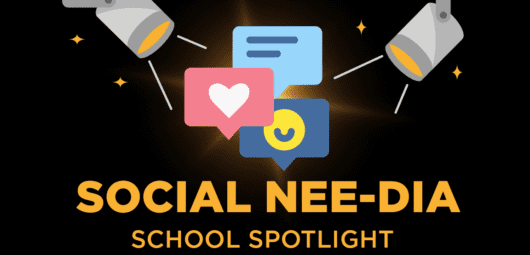Feedback from Users Guided Redesign of NEE’s EdHub Library
If you have been a part of NEE for at least five years, you likely remember our former EdHub Library. It was on a separate platform than the NEE Data Tool, required tokens to login, and it took several clicks of the mouse to open a single professional learning activity. It was not exceptionally simple to use, and the Network for Educator Effectiveness instructional design team recognized the need for an overhaul.
In 2017, our team began work to improve the accessibility and usability of EdHub. By August 2018, we launched an integrated version of the EdHub professional learning library within the NEE Data Tool, making it easier to access and use for NEE school leaders and teachers.
EdHub instructional designer Javier Leung recently wrote an article, published in the International Journal of Design for Learning, that describes the design case for redeveloping the EdHub Library.
Listening to Our Users
The EdHub Library enables teachers to access resources online and plan for professional growth based on self-identified professional development or PD recommended by their school leader. In combination with the NEE evaluation system, EdHub supports educators’ professional growth and development.
The first iteration of EdHub was built in 2014 on a platform called Plone with funding from the Bill and Melinda Gates Foundation in partnership with the University of Missouri. It was a separate platform from the NEE Data Tool, which required users to register and to have an additional login.
Feedback from EdHub users indicated that a redesign was necessary in order to better serve teachers and school leaders.
In 2016, NEE surveyed teachers about their use of EdHub and asked administrators to voice their perspectives during NEE’s annually required evaluator training. Feedback from the teacher survey and in-person training sessions with administrators identified the following themes:
- EdHub’s navigation and usability needed to improve.
- The platform needed to be accessible to all NEE schools without a login and user registration.
- There were privacy and sharing concerns that needed to be eliminated related to teachers’ EdHub journal entries.
- The platform should be maintained in-house.
Search analytics data from the first generation of EdHub also informed design decisions for the second generation. Analytics showed that users performed specific searches related to the NEE teacher indicators (e.g. 1.1, 1.2, 5.1 instead of actual words) and particular processes for professional development (e.g. professional development plans, units of instruction, classroom observation videos, and student surveys).
Redesigning EdHub
Equipped with this feedback, the EdHub instructional design team got to work on a more user-friendly iteration of the library.
Overall, the second generation of EdHub encapsulated five design decisions in the development and testing of two prototypes and two user testing sessions:
- Visual priority of elements. This involved previewing all topics from the library homepage and their alignment with teacher indicators, accessing instructional modules in two or three steps, and recognizing the location of materials with breadcrumb navigation available in all pages of the library.
- Ease of navigation. The navigation structure changed from a sequential navigation scheme to a hierarchical structure, which allowed users to navigate the library in three steps or less with consistent alignment with teacher indicators.
- Browsing materials by teacher indicators. Consistent with the way users found materials in the first generation, a design decision that carried over was a listing of materials by teacher indicator. Teacher indicator sitemaps enabled users to find specific professional development with alignment to indicators regardless of the type of professional development activity.
- Searching across multiple content topics. A search engine allowed users to look for information based on keywords of interest.This feature enabled users to locate materials across multiple topics and modules without consideration for the alignment with teacher standards.
- Consolidating module activities, resources, and reflection within a single page. Instead of using multiple pages, the components of an instructional module were logically laid out in a single page that includes learning objectives, activities and tasks, and resources.
Reflection
Listening to users and responding to their needs has been a priority for NEE since its inception. In the case of redeveloping EdHub, the team received feedback from teachers and administrators and analyzed their usage habits to determine the best design for a second iteration of the professional learning library.
Design changes improved accessibility and navigation through the use of visual cues, multiple ways to search for materials, and popular materials bookmarked at the top of the homepage. Users can now open a professional learning activity in three or fewer steps. Bringing EdHub under the hood of the NEE Data Tool made access to the library exceptionally simple.
The design decisions implemented in the second generation of EdHub support the self-regulation activities of teachers and school administrators as they acquire professional development.
Our team continues to add materials to the EdHub library that support teachers’ growth and development. Most recently, we have added two topics in response to users’ needs:
- Building Instructional Skills: This topic includes modules that focus on introducing and building essential instructional skills. Each module is aligned with a NEE indicator and includes three activities that can support teachers’ professional learning based on the classroom observation score they received for that indicator.
- Culturally Responsive Teaching: This topic includes modules that address research-based practices that support culturally responsive teaching, or instruction that is sensitive to cultures, languages, communities, and families of students.
If you have feedback for EdHub or for NEE, please let us know by emailing nee@missouri.edu.
The Network for Educator Effectiveness (NEE) is a simple yet powerful comprehensive system for educator evaluation that helps educators grow, students learn, and schools improve. Developed by preK-12 practitioners and experts at the University of Missouri, NEE brings together classroom observation, student feedback, teacher curriculum planning, and professional development as measures of effectiveness in a secure online portal designed to promote educator growth and development.




